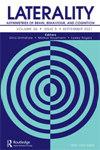大脑动机不对称是否介导了利手性和个性之间的关系?
IF 1.5
4区 心理学
Q4 PSYCHOLOGY, EXPERIMENTAL
引用次数: 1
摘要
惯用手一直以来都与性格有关,但缺乏对这种联系的详细解释。重要的是,对于理论发展的目的,与五大人格特征相关的接近和退缩的测量也可以追溯到与利手性相关的大脑区域的活动。具体来说,右半球额叶活动的增加似乎与退缩动机和左/不一致手性有关,而左半球额叶活动的增加与接近动机和右/一致手性有关。因此,大脑动机不对称提供了一种可能的机制,通过这种机制,接近动机和退缩动机可以调解利手性和个性之间的关系。我们在一项大型在线研究(N = 499)中测试了这种可能性,其中参与者完成了多项调查措施。结果表明,接近/退缩动机部分解释了利手性与个性之间的关系。本文章由计算机程序翻译,如有差异,请以英文原文为准。
Do cerebral motivational asymmetries mediate the relationship between handedness and personality?
ABSTRACT Handedness has long been tied to personality, but detailed explanations for the association are lacking. Importantly for purposes of theory development, measures of approach and withdrawal associated with Big Five personality traits have also been traced back to activity in brain areas that relate to handedness. Specifically, increased right-hemisphere frontal activity appears to be linked to both withdrawal motivation and left/inconsistent-handedness, while increased left-hemisphere frontal activity is associated with approach motivation and right/consistent-handedness. Cerebral motivational asymmetries therefore present one plausible mechanism by which approach and withdrawal motivation could mediate the relationship between handedness and personality. We tested this possibility in a large online study (N = 499) in which participants completed multiple survey measures. Results indicated that approach/withdrawal motivation partially accounts for relationships between handedness and personality.
求助全文
通过发布文献求助,成功后即可免费获取论文全文。
去求助
来源期刊

Laterality
Multiple-
CiteScore
3.60
自引率
7.10%
发文量
26
期刊介绍:
Laterality: Asymmetries of Body, Brain and Cognition publishes high quality research on all aspects of lateralisation in humans and non-human species. Laterality"s principal interest is in the psychological, behavioural and neurological correlates of lateralisation. The editors will also consider accessible papers from any discipline which can illuminate the general problems of the evolution of biological and neural asymmetry, papers on the cultural, linguistic, artistic and social consequences of lateral asymmetry, and papers on its historical origins and development. The interests of workers in laterality are typically broad.
 求助内容:
求助内容: 应助结果提醒方式:
应助结果提醒方式:


